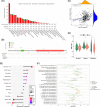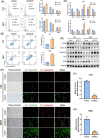SQLE Knockdown inhibits bladder cancer progression by regulating the PTEN/AKT/GSK3β signaling pathway through P53
- PMID: 37770925
- PMCID: PMC10540347
- DOI: 10.1186/s12935-023-02997-5
SQLE Knockdown inhibits bladder cancer progression by regulating the PTEN/AKT/GSK3β signaling pathway through P53
Abstract
Bladder cancer (BCa) is one of the most common malignancies worldwide. However, the lack of accurate and effective targeted drugs has become a major problem in current clinical treatment of BCa. Studies have demonstrated that squalene epoxidase (SQLE), as a key rate-limiting enzyme in cholesterol biosynthesis, is involved in cancer development. In this study, our analysis of The Cancer Genome Atlas, The Genotype-Tissue Expression, and Gene Expression Omnibus databases showed that SQLE expression was significantly higher in cancer tissues than it was in adjacent normal tissues, and BCa tissues with a high SQLE expression displayed a poor prognosis. We then confirmed this result in qRT-PCR and immunohistochemical staining experiments, and our vitro studies demonstrated that SQLE knockdown inhibited tumor cell proliferation and metastasis through the PTEN/AKT/GSK3β signaling pathway. By means of rescue experiments, we proved that that P53 is a key molecule in SQLE-mediated regulation of the PTEN/AKT/GSK3β signaling pathway. Simultaneously, we verified the above findings through a tumorigenesis experiment in nude mice. In conclusion, our study shows that SQLE promotes BCa growth through the P53/PTEN/AKT/GSK3β axis, which may serve as a therapeutic biological target for BCa.
Keywords: Apoptosis; Bladder cancer; Cell cycle; P53; PTEN/AKT/GSK3β signaling pathway; Proliferation; SQLE.
© 2023. BioMed Central Ltd., part of Springer Nature.
Conflict of interest statement
The authors declare no competing interests.
Figures










Similar articles
-
Reduction of Squalene Epoxidase by Cholesterol Accumulation Accelerates Colorectal Cancer Progression and Metastasis.Gastroenterology. 2021 Mar;160(4):1194-1207.e28. doi: 10.1053/j.gastro.2020.09.009. Epub 2020 Sep 15. Gastroenterology. 2021. PMID: 32946903
-
Squalene epoxidase-induced cholesteryl ester accumulation promotes nasopharyngeal carcinoma development by activating PI3K/AKT signaling.Cancer Sci. 2020 Jul;111(7):2275-2283. doi: 10.1111/cas.14426. Epub 2020 May 14. Cancer Sci. 2020. Retraction in: Cancer Sci. 2022 Apr;113(4):1548. doi: 10.1111/cas.15305. PMID: 32314495 Free PMC article. Retracted.
-
Age-related cholesterol and colorectal cancer progression: Validating squalene epoxidase for high-risk cases.Aging Cell. 2024 Jul;23(7):e14152. doi: 10.1111/acel.14152. Epub 2024 Mar 22. Aging Cell. 2024. PMID: 38517197 Free PMC article.
-
Advances in understanding the role of squalene epoxidase in cancer prognosis and resistance.Mol Biol Rep. 2025 Jan 27;52(1):162. doi: 10.1007/s11033-025-10276-x. Mol Biol Rep. 2025. PMID: 39869140 Review.
-
Squalene Epoxidase: Its Regulations and Links with Cancers.Int J Mol Sci. 2024 Mar 30;25(7):3874. doi: 10.3390/ijms25073874. Int J Mol Sci. 2024. PMID: 38612682 Free PMC article.
Cited by
-
Squalene monooxygenase (SQLE) protects ovarian cancer cells from ferroptosis.Sci Rep. 2024 Sep 30;14(1):22646. doi: 10.1038/s41598-024-72506-9. Sci Rep. 2024. PMID: 39349544 Free PMC article.
-
Cholesterol metabolism: physiological regulation and diseases.MedComm (2020). 2024 Feb 24;5(2):e476. doi: 10.1002/mco2.476. eCollection 2024 Feb. MedComm (2020). 2024. PMID: 38405060 Free PMC article. Review.
-
Inhibition of KDM4A restricts SQLE transcription and induces oxidative stress imbalance to suppress bladder cancer.Redox Biol. 2024 Nov;77:103407. doi: 10.1016/j.redox.2024.103407. Epub 2024 Oct 22. Redox Biol. 2024. PMID: 39461328 Free PMC article.
-
Hypoxia-induced HIF-1α/VASN promotes bladder cancer progression.Sci Rep. 2025 Jul 1;15(1):21635. doi: 10.1038/s41598-025-05929-7. Sci Rep. 2025. PMID: 40594164 Free PMC article.
-
Review of recent molecular pathology of bladder urothelial carcinoma.Discov Oncol. 2025 Mar 29;16(1):424. doi: 10.1007/s12672-025-02128-8. Discov Oncol. 2025. PMID: 40156709 Free PMC article. Review.
References
-
- Mok TS, Cheng Y, Zhou X, et al. Updated overall survival in a Randomized Study comparing Dacomitinib with Gefitinib as First-Line treatment in patients with Advanced Non-Small-Cell Lung Cancer and EGFR-Activating Mutations[J] Drugs. 2021;81(2):257–66. doi: 10.1007/s40265-020-01441-6. - DOI - PMC - PubMed
Grants and funding
LinkOut - more resources
Full Text Sources
Research Materials
Miscellaneous

